Mark Sisson's Blog, page 157
January 21, 2018
Weekend Link Love — Edition 487
 Research of the Week
Research of the WeekPotential mechanisms behind the links between full-fat dairy and health.
Religious belief predicts compassionate love.
A close relative of ketamine treats the most resistant type of depression.
CBD helps those with schizophrenia..
High-dose vitamin D reduces PMS in teen girls. Indirect benefits for teen boys.
New Primal Blueprint Podcasts

Episode 211: Joel Jamieson: Host Brad Kearns chats with Joel Jamieson about what most people get wrong about training, recovery, rest, and energy.
Each week, select Mark’s Daily Apple blog posts are prepared as Primal Blueprint Podcasts. Need to catch up on reading, but don’t have the time? Prefer to listen to articles while on the go? Check out the new blog post podcasts below, and subscribe to the Primal Blueprint Podcast here so you never miss an episode.
Interesting Blog Posts
Swedish tips for outdoor parenting.
Doctors, coaches, and athletes are finally realizing that female athletes who get enough rest, recovery, and calories to avoid the female athlete triad perform better.
Media, Schmedia
The UK now has a Ministry of Loneliness. This isn’t normal.
A nice overview of how fiber benefits health.
Everything Else
Putin shows the health benefits of certain traditions.
Overlooked thanks to its propensity to degrade over time, the stick played a huge role in human evolution.
The boy who stayed awake for 11 days.
Things I’m Up to and Interested In
Podcast I’m liking: The Insight, a podcast all about human population genetics, ancient history, ancienter prehistory, and migration.
Video I’m digging: Central African pygmies building a bridge across croc-infested waters.
Area of research I’m eyeing: The interplay between the gut biome and physical performance.
Article I found fascinating: Is general anesthesia general amnesia? How we might consciously experience—but soon forget—surgery.
Great AMA: A pair of CRISPR experts.
Recipe Corner
Why do Brussels sprouts have such a bad reputation? Because most people don’t roast them with bacon.
Eye of round is an inexpensive cut, but it’s fantastic.
Time Capsule
One year ago (Jan 21– Jan 27)
Dear Mark: More of Your Challenge Questions Answered – A nice Q&A.
Contest Poll: Primal Blueprint Recipe Videos – Watch, get hungry, get cooking.
Comment of the Week
“Making stainless steel pans non-stick: Heat up on the stove, like, really, really hot. Put in some oil (I prefer coconut), about a tablespoon and swirl it around till it smokes. Dump out the oil. Turn off heat, and sprinkle kosher salt in the pan, a nice layer on the bottom. Using a handful of paper towels, rub the salt around, including the sides, like you are scouring the pan. Be careful not to burn yourself. After a minute or two, dump out the salt and wipe pan clean, It is no seasoned! You’ll note that the surface seems much smoother and slicker than before.
The key is to then use some fat in an already-heated pan. Like The Frugal Gourmet on PBS used to say, “Cold Oil, Hot Pan, Food Won’t stick.” For scrambled eggs (Mark!) or an omelet, I take a stick of butter and manually rub it all around the pan after it’s heated, to coat it well. Let it heat another moment, you want it hot enough that a water drop will ‘roll’ around. Then put in the eggs. Voila. Scrambled are a piece of cake and if you make an omelet, or fired eggs, they won’t won’t stick.
I clean the pan just with a paper towel, not soapy water (treat it like you would a seasoned cast iron pan) and it will stay non-stick for a good while. I repeat the seasoning process every couple months, depending on use.”
– Great comment, Pcskier.
Want to make fat loss easier?
Try the Definitive Guide for Troubleshooting Weight Loss for free here.
The post Weekend Link Love — Edition 487 appeared first on Mark's Daily Apple.



January 20, 2018
Instant Pot Pulled Pork Coconut Curry
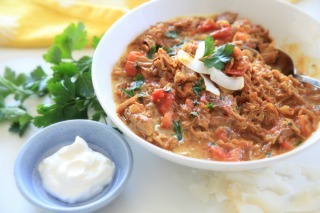 This is succulent pulled pork with an Indian twist. The pork is swimming in a fragrant coconut sauce rich with spices like garam masala, turmeric, coriander, and cinnamon (plus, lots of onion, garlic, and ginger).
This is succulent pulled pork with an Indian twist. The pork is swimming in a fragrant coconut sauce rich with spices like garam masala, turmeric, coriander, and cinnamon (plus, lots of onion, garlic, and ginger).
This recipe is made in two parts. First, cook the pork shoulder. Then, simmer the coconut curry sauce. Using one pot, the Instant Pot, for both steps keeps the cooking time and the dirty dishes to a minimum.
Typically, pork shoulder is cut into small stew pieces for curries. On some days though this step can feel like too much time and effort. So, for this recipe, the pork is cooked in large pieces instead and then shredded into the sauce.
Serve Instant Pot Pulled Pork Coconut Curry with sweet potatoes or roasted squash. It’s also great with sautéed greens on the side.
Time in the Kitchen: 1 hour of hands-on cooking time, plus 80 minutes in the pressure cooker
Servings: 6 to 8
Pork Ingredients

3 to 4 pound boneless pork shoulder, cut into 4 pieces (1.4 to 1.8 kg)
Juice of 1 lemon (about 1/4 cup/60 ml)
2 tablespoons avocado oil (30 ml)
1 tablespoon garam masala (15 ml)
1 teaspoon garlic powder (5 ml)
¼ teaspoon cinnamon (1.2 ml)
2 teaspoons kosher salt (10 ml)
Coconut Sauce Ingredients

2 tablespoons coconut oil, divided (30 ml)
1 tablespoon unsalted butter or ghee (15 ml)
1 14.5-ounce can diced tomatoes (411 g)
1 large onion, chopped
4 garlic cloves, finely chopped or pressed
2-inches/50 mm peeled ginger root, grated
1 teaspoon garam masala (5 ml)
1/2 teaspoon turmeric (2.5 ml)
1/2 teaspoon cumin (2.5 ml)
1/2 teaspoon coriander (2.5 ml)
1/2 teaspoon salt (2.5 ml)
1/4 teaspoon cardamom (2.5 ml)
1/4 teaspoon cinnamon (1.2 ml)
Instructions
Recipe Tip: The pork can be made a day head, or be made on the same day as the coconut curry sauce.
For the pork, mix together lemon juice, avocado oil, garam masala, garlic powder, cinnamon, and salt. Pour marinade over the pork pieces. Marinate 30 to 60 minutes at room temperature (while prepping the rest of the ingredients) or several hours in the refrigerator.
Using the sauté function of an electric pressure cooker (like an Instant Pot) set on medium, heat one tablespoon of coconut oil. Lift each piece of pork out of the marinade, shaking excess marinade off (save the marinade). Cook the pieces of pork until browned on all sides; about 8 minutes total for each piece. If the pot gets too hot and the spices on the pork start to burn, turn down the heat, and/or add more oil.
When the pork is browned, pour the remaining marinade into the pot. Add 1/4 cup (180 ml) water. Use a wooden spoon or spatula to loosen any bits of meat that have stuck to the bottom of the pot.
With all the pork in the pot, cover and lock the lid. Set the pressure cooker to cook for 80 minutes under high pressure. Make sure the valve is in the “sealed” position. When 80 minutes has passed, let the pressure release naturally (about 15 minutes).
Take the pork out of the broth; shred when cooled. Reserve ¼ cup of the broth; the rest can be refrigerated for another use (add to soups or stews for extra flavor, or use the broth to flavor meat or roasted vegetables.)
Using the pressure cooker’s sauté function on medium, heat the unsalted butter or ghee, plus the remaining tablespoon of coconut oil. Add onion, cook until soft and nicely browned, 8 to 10 minutes. Be careful that the onion doesn’t burn; turn heat to low if necessary. When the onion is nicely browned, add garlic and ginger and cook 1 minute more. Add turmeric, garam masala, cumin, coriander, cinnamon and cardamom. Add tomatoes, ½ cup coconut milk and ¼ cup of the broth left from cooking the pork.
Bring sauce to a simmer. Simmer five minutes, then stir in the pork. Simmer 10 minutes more, stirring occasionally.
Before serving, taste and add salt or more coconut milk if desired. Garnish with cilantro or parsley, and an optional dollop of whole milk yogurt.
Instant Pot Pulled Pork Coconut Curry is a recipe that tastes good the first day, and even better the next day, when the spices and flavors have time to meld.

The post Instant Pot Pulled Pork Coconut Curry appeared first on Mark's Daily Apple.



January 19, 2018
I’m Taking Patients Off More Medications Than I’m Prescribing
It’s Friday, everyone! And that means another Primal Blueprint Real Life Story from a Mark’s Daily Apple reader. If you have your own success story and would like to share it with me and the Mark’s Daily Apple community please contact me here. I’ll continue to publish these each Friday as long as they keep coming in. Thank you for reading!
 In 2011 I was 80 lbs overweight, I was on 8 medications, I was sick, sad, and scared. As a doctor, I couldn’t understand how I’d ended up there. I “knew” what to do. I just had to eat less and exercise more, right?
In 2011 I was 80 lbs overweight, I was on 8 medications, I was sick, sad, and scared. As a doctor, I couldn’t understand how I’d ended up there. I “knew” what to do. I just had to eat less and exercise more, right?
I’d done Weight Watchers (which worked for a while, until I gained all the weight, plus more, back), seen a nutritionist, a therapist, and even a hypnotist to control my lack of willpower.
I was eating low-fat meat and dairy, whole grains, and tightly controlling my portions. I ate vegetarian meals frequently and snacked on pretzels and hummus, and chips and salsa. I went to the gym 3 times a week and did 30 minutes of cardio. I was doing everything “right,” and this was me.
 One day a friend, who had no medical background, told me he was going to do this “Paleo” diet. Meats, eggs, nuts, fruits and veggies. No grains, no dairy, no legumes. I was horrified. “You can’t do that,” I said, “you will DIE!” All that meat and eggs and fat would spike his cholesterol, no dairy and his bones would all break, no grains and he wouldn’t get any fiber. “Wait,” I said. “Don’t do anything crazy. Let me research it and get back to you.”
One day a friend, who had no medical background, told me he was going to do this “Paleo” diet. Meats, eggs, nuts, fruits and veggies. No grains, no dairy, no legumes. I was horrified. “You can’t do that,” I said, “you will DIE!” All that meat and eggs and fat would spike his cholesterol, no dairy and his bones would all break, no grains and he wouldn’t get any fiber. “Wait,” I said. “Don’t do anything crazy. Let me research it and get back to you.”
So, I set out to save my friend’s life. To find evidence to convince him that this Mark Sisson guy was crazy. What I found was shocking. I read Loren Cordain, Robb Wolf. And it all made sense. From a biochemical standpoint, based on everything I knew about physiology, it all made sense.
Well, I knew that couldn’t be right, so I set out looking for criticism of the Paleo diet. And none of it made sense. The criticisms were weak, they were not based in science.
So, I did it. For 4 months I ate Paleo. I lost 20 lbs, I felt better, and I wasn’t so damn hungry all the time like I’d been on Weight Watchers.
Then life, a move, and a divorce got in the way. But in 2013 I found It Starts With Food. I read it while I polished off a box of donuts and cried. I didn’t know why I couldn’t stop the donuts, but Dallas and Melissa told me. I did a Whole30. I kept reading medical articles supporting this lifestyle. I met Dallas Hartwig in 2014. I was still struggling because over enthusiastic exercise had led to injuries. He told me “Just walk. You can still be an athlete if you just walk.” So I started walking. And walking.
 And in 2015 I walked a half marathon. I got serious about eating well. I started dropping medications (with my doctors permission). I had followed Mark’s Daily Apple sporadically, but when the New Primal Blueprint came out, I bought it. I still believe It Starts With Food, but it doesn’t end there. I was ready to dial in my exercise, my sleep, my relationships, my stress.
And in 2015 I walked a half marathon. I got serious about eating well. I started dropping medications (with my doctors permission). I had followed Mark’s Daily Apple sporadically, but when the New Primal Blueprint came out, I bought it. I still believe It Starts With Food, but it doesn’t end there. I was ready to dial in my exercise, my sleep, my relationships, my stress.
I have lost 70 lbs, I’ve lost 6 clothes sizes. I no longer take any of those 8 medicines. I lost my depression, my anxiety, my snoring, my insomnia, my rosácea, my thinning hair, my chronic constipation, and my glasses/contacts. I’ve lost cravings. I’ve lost interest in highly palatable junk food. I’ve lost the need for “willpower” over food. I’ve climbed glaciers in Iceland and volcanoes in Hawai’i. My sex drive is back, and I have the stamina to enjoy it. I’m happy, peaceful, and calm.
I’ve cured patients of diabetes, high blood pressure, high cholesterol, sleep apnea, rosácea, IBS, PCOS, and autoimmune disease. I’m taking patients off more medicines than I’m prescribing.
I’m inspiring others. I’m inspiring my kids. I’m inspiring myself.
Happy, healthy, fit, confident. I enjoy exercise, I don’t obsess about food, I sleep like a baby and wake with the sun. I turn off my phone and read books. I have a loving relationship. Life is good.
I’m Grokking On!
Joanne Watson, MD


The post I’m Taking Patients Off More Medications Than I’m Prescribing appeared first on Mark's Daily Apple.



Primal Action Point: 5 Fitness Recovery Techniques
 Fitness recovery isn’t only about rest. Certain techniques offer faster, more effective recovery after endurance or high intensity training—a big plus for those who compete or follow more intensive fitness programs like CrossFit. By the way, if you missed this week’s feature, Rest and Recovery: A Whole New Perspective, be sure to check it out.
Fitness recovery isn’t only about rest. Certain techniques offer faster, more effective recovery after endurance or high intensity training—a big plus for those who compete or follow more intensive fitness programs like CrossFit. By the way, if you missed this week’s feature, Rest and Recovery: A Whole New Perspective, be sure to check it out.
Now onto those techniques…
Cold therapy can help speed recovery by delivering a refreshing psychological sensation and recalibrating the central nervous system and muscle metabolic activity back to calm, cool resting levels. Full body immersion into water at 50 ºF to 60 ºF (10 ºC to 15 ºC) for five to ten minutes, is believed to be the optimal strategy for post-exercise cold therapy.
The old injury treatment protocol of RICE (Rest, Ice, Compression, Elevation) is being replaced in the eyes of many experts with ECM (Elevate, Compress, Move). Icing of injuries can retard the natural healing process.
Compression wraps or garments act like pumps to squeeze blood vessels open with force, allowing more blood and oxygen into the area and improving removal of waste and excess fluid. Studies suggest reduced muscle soreness and improved performance using compression garments.
Movement is also an important element of recovery. Athletes should refrain from prolonged stillness periods after workouts, and throughout the day. Over time, efforts to move more will result in improvements in the familiar morning stiffness that many athletes experience.
Self-myofascial release is an effective recovery technique. Using rollers or balls, you can apply deep pressure to trigger points that represent the origination of stiffness and mobility problems, which possibly refer pain elsewhere. Self-myofascial release delivers the added benefit of stimulating the parasympathetic nervous system, allowing you to truly unwind after workouts.
— From Primal Endurance: Escape Chronic Cardio and Carbohydrate Dependency and Become a Fat-Burning Beast
For more fitness recovery techniques, check out Primal Endurance and “7 Things You May Be Doing That Impair Workout Recovery.”
Want to make fat loss easier?
Try the Definitive Guide for Troubleshooting Weight Loss for free here.
The post Primal Action Point: 5 Fitness Recovery Techniques appeared first on Mark's Daily Apple.



January 6, 2018
Slow Cooker Chicken Cacciatore
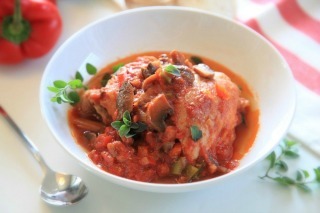 Who doesn’t love a meal that cooks itself? Especially when it’s easy, reliably delicious comfort food like chicken cacciatore? Throw this recipe into a slow cooker and come back hours later to a hearty dinner. Even better, this recipe serves 8, which should take care of more than one meal. Chicken cacciatore tastes great leftover the next day, and it also freezes well.
Who doesn’t love a meal that cooks itself? Especially when it’s easy, reliably delicious comfort food like chicken cacciatore? Throw this recipe into a slow cooker and come back hours later to a hearty dinner. Even better, this recipe serves 8, which should take care of more than one meal. Chicken cacciatore tastes great leftover the next day, and it also freezes well.
If you’re not familiar with chicken cacciatore, it’s classic Italian-American food. Tender chicken falls off the bone into a thick sauce of tomatoes, bell peppers, mushrooms and garlic. It’s flavorful—but in a mild “everyone’s gonna like this” sort of way.
A slow cooker is a perfect place to cook bone-in chicken thighs. The meat becomes tender and flavorful, never mushy and bland. Browning the chicken (and onion) before adding it to the slow cooker gives the dish better flavor and texture; it’s not strictly necessary, but if you have the time then it’s worth the effort.
Chicken cacciatore can be served over something—like gluten-free pasta, cauliflower rice or spaghetti squash—but it doesn’t need to be. This meal is plenty flavorful and filling simply served alone in a bowl.
Servings: 8
Time in the Kitchen: 20 minutes, plus 4 to 8 hours in a slow cooker
Ingredients

8 to 10 bone-in, skinless* chicken thighs
5 garlic cloves, thinly sliced or finely chopped
1 onion, finely chopped
1 28-ounce/794 g can crushed tomatoes
1 green bell pepper, chopped
1 red bell pepper, chopped
8 ounces cremini mushrooms, sliced (227 g)
1 bay leaf
A pinch of red pepper flakes
Optional Garnishes: fresh basil or oregano, capers or black olives, Parmigiano-Reggiano cheese
Instructions

*For this recipe, leaving the chicken skin on the chicken thighs tends to make the dish too oily
Season the chicken generously with salt. Heat a skillet over medium-high heat with a drizzle of avocado oil or extra virgin olive oil. When the skillet is hot, add chicken. Cook until lightly browned, about 4 minutes a side. Do not crowd the chicken in the skillet; brown in two batches if necessary.
Add the browned chicken to the slow cooker.
In the same skillet that the chicken was cooked, add the onions. Turn heat down to medium. Saute until onions are soft, 5 to 8 minutes. Add garlic and cook 1 minute more. Season lightly with salt.
Add onion and garlic to slow cooker. Add tomatoes, bell peppers, mushrooms, bay leaf and red pepper flakes. Mix well, so the chicken is completely coated in tomatoes.
Cover and cook on high 4 hours, or low 8 hours.
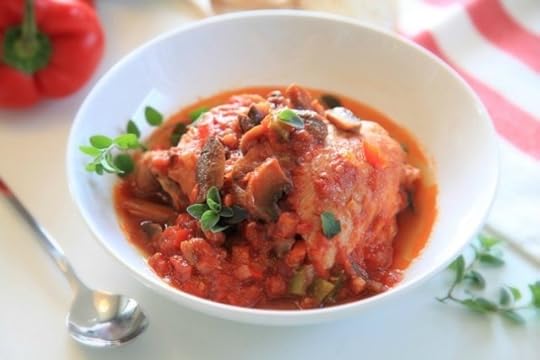
The post Slow Cooker Chicken Cacciatore appeared first on Mark's Daily Apple.



January 5, 2018
Sweet 60: I’m More Fit Than Ever!
It’s Friday, everyone! And that means another Primal Blueprint Real Life Story from a Mark’s Daily Apple reader. If you have your own success story and would like to share it with me and the Mark’s Daily Apple community please contact me here. I’ll continue to publish these each Friday as long as they keep coming in. Thank you for reading!
 I read The Primal Blueprint a little over a year ago and was inspired to try it. For decades I’ve been health conscious but have had little success avoiding the yo-yo cycle of weight gain/weight loss. The worst mistake I made was succumbing to the low fat craze in the 80s. I was a marketer’s dream!
I read The Primal Blueprint a little over a year ago and was inspired to try it. For decades I’ve been health conscious but have had little success avoiding the yo-yo cycle of weight gain/weight loss. The worst mistake I made was succumbing to the low fat craze in the 80s. I was a marketer’s dream!
I became aware of the perils of “white poison” (sugar, bread, etc.) about 10 years ago. As a nurse anesthetist, I was seeing an alarming number of children coming to surgery either overweight or obese with some of the maladies that come with it. Most notable were high blood pressure, high lipids, and depression. They were already taking a host of medications to
treat them as young as age 10!
It inspired me to write and publish a booklet called “Carbavoid….The Fuel for the Future,” but I was still delusional about grains and touted whole grains as a part of a healthy diet. Until I read The Primal Blueprint I was completely unaware of how unhealthy my diet was. I was amazed as I read it and became obsessed with learning all I could.
 I was surprised at all the information out there and yet surprised that there was so little knowledge about it in the general public. I readily consumed whole grains, dairy, soy, peanuts and legumes proudly, thinking I was promoting a healthy lifestyle. I also suffered daily bloating and abdominal discomfort, daily mid afternoon lethargy, and arthritis (that I blamed on genetics).
I was surprised at all the information out there and yet surprised that there was so little knowledge about it in the general public. I readily consumed whole grains, dairy, soy, peanuts and legumes proudly, thinking I was promoting a healthy lifestyle. I also suffered daily bloating and abdominal discomfort, daily mid afternoon lethargy, and arthritis (that I blamed on genetics).
When I decided to go Primal I spent a few days preparing, and I suggest this for anyone else. I cleansed my pantry of all the things mentioned above. A list can also be found in any Paleo related source. Then I carefully shopped around to stock my pantry and fridge with organic vegetables, uncured meats, cage free chicken and eggs….lots of eggs, ghee, macadamia nuts, berries, and olive, coconut and avocado oils.
The 1st week was very difficult and I kept a daily journal to document my progress. I’m so glad I did because I recently read it from the beginning and was so proud of myself for persevering. I suffered from brain fog and fatigue until day 5 when it gradually began to clear up. Then I experienced near euphoria as my mental clarity improved and energy level skyrocketed!
By the end of the month I noticed a decrease in knee pain from my arthritis and even canceled an injection I was due for. After the 1st month I knew I was hooked. I didn’t want to introduce anything that I avoided to start with, but I did eat a little more fruit. I began running and biking the low level way described in the book. I actually enjoyed working out because there was no pain involved.
I also went to the gym for 30-45 minute workouts for my muscle growth. Weight that had hung on my midsection for decades began to melt away. As my upper body became more lean I could appreciate the muscle growth I was obtaining.
As each month passed I would see another 2-3 pounds of fat melted away. It was comfortably slow because I was never hungry. After about 10 months I realized I was at a stabilizing weight and added more nuts and paleo protein friendly bars and shakes to my diet.
 It’s been 13 months now, and I am at a weight I haven’t seen since my early 20s! I am happy with my muscle definition, and strangers have complimented me out of the blue in public. I am more fit at age 60 than I’ve ever been in my life! I have motivated many coworkers and am happy to be a consultant for them when they are inquisitive about this lifestyle.
It’s been 13 months now, and I am at a weight I haven’t seen since my early 20s! I am happy with my muscle definition, and strangers have complimented me out of the blue in public. I am more fit at age 60 than I’ve ever been in my life! I have motivated many coworkers and am happy to be a consultant for them when they are inquisitive about this lifestyle.
I will never go back to the lifestyle I lived for the first 58 years of my life. I choose not to have many “cheat” days, though I confess on Christmas I ate one of my mom’s yeast rolls AND a piece of her pecan pie with no harm done.
I encourage anyone but especially those who are already diagnosed with pre- or type II diabetes to give this lifestyle a chance. I guarantee that you will alter the course of your future for the better.
Good luck and hang in there!!
Sincerely,
Cindy Howlett


The post Sweet 60: I’m More Fit Than Ever! appeared first on Mark's Daily Apple.



Primal Challenge Point: Slow Down
 With the holidays just behind us, I’d say this weekend offers the perfect opportunity to slow life down and spend some time in flagrant leisure. The holidays are fun of course (they certainly offer some good parties…), but several weeks’ worth of erratic schedules, a full social calendar, and extra to-dos can take a toll—particularly for some of us. It’s little wonder people quietly welcome the return to routine after it’s all over.
With the holidays just behind us, I’d say this weekend offers the perfect opportunity to slow life down and spend some time in flagrant leisure. The holidays are fun of course (they certainly offer some good parties…), but several weeks’ worth of erratic schedules, a full social calendar, and extra to-dos can take a toll—particularly for some of us. It’s little wonder people quietly welcome the return to routine after it’s all over.
January comes with a good deal of capital for self-improvement, but what if we also claimed it as a time for self-centering? If we didn’t have the agendas of the outside world to consider, how would we choose to spend our days? What rhythm truly suits us best?
While most of us won’t be quitting our 8-5 jobs and living like Grok did, we can be more intentional stewards of our free time. What will we do with that freedom?
From Primal Connection:
“How do I see the connection between slow living and Primal living? I think slow living on some level reclaims what is natural in human relations, basic sustenance, and life balance. More than that, however, I like how slow living in many respects brings us closer to some of our evolutionary patterns. …There’s a reason we miss quiet weekends untethered to technology. There’s a reason a city with ample park space and a vibrant pedestrian zone feels more inviting than a congested sea of skyscrapers and cars. There’s a reason we feel uniquely fulfilled cooking and sharing a homemade meal with others. These were the basic experiences of our ancestors. Humanity evolved with rhythms and rituals that modern acceleration has left in the dust. Our psyches haven’t caught up with the change of pace. Life makes more sense the slow way.”
Primal Challenge Point: What will you do this weekend to enjoy a slower, healthier, more self-attuned rhythm?
The post Primal Challenge Point: Slow Down appeared first on Mark's Daily Apple.



January 4, 2018
10 Freezer-Friendly Meals (and a Giveaway)
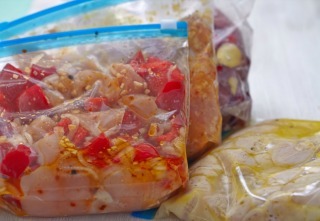 Health is about action. If your resolution doesn’t transfer to your routine, it will be dead in the water. Now’s the time to think about what in your routine needs to change to accommodate new choices. Healthy eating, for one, can be simple, but it requires some forethought. Strategic preparation helps, too. In that spirit, we’ve got a practical guide you can apply right away to your Primal diet—not to mention this weekend’s shopping list. Enjoy, everyone.
Health is about action. If your resolution doesn’t transfer to your routine, it will be dead in the water. Now’s the time to think about what in your routine needs to change to accommodate new choices. Healthy eating, for one, can be simple, but it requires some forethought. Strategic preparation helps, too. In that spirit, we’ve got a practical guide you can apply right away to your Primal diet—not to mention this weekend’s shopping list. Enjoy, everyone.
Stocking your freezer with homemade food is a winning strategy for eating well, especially when life gets really busy. There’s no better feeling than knowing that dinner is already cooked and just needs to be reheated. The easiest way to fill your freezer with meals is to regularly double, or triple, recipes so you regularly have leftovers to freeze. Of course, some meals freeze better than others. Here’s a handy guide for freezing cooked food, plus 10 recipes you should definitely have in your freezer.
How to Freeze & Defrost Cooked Food
Containers
Tupperware (or freezer-friendly Pyrex containers) and freezer bags are the most convenient containers for freezing food. Freezer bags are especially easy to label and space efficient. Fill a bag with food, smooth it out into an even layer and press out all the air (the less air in the bag, the less chance of freezer burn). Flat freezer bags filled with food stack up conveniently in the freezer.
Food Safety
Don’t put hot food in the freezer; always cool it completely first. As a general rule, frozen, cooked food will taste best if eaten within 3 months. If it helps, keep an inventory of frozen meals taped to your freezer door so you don’t forget what’s in there.
Portions
Consider freezing individual portions rather than freezing a big portion of food in one bag. This allows you to defrost a little bit at a time. This is an especially good idea if you want to use frozen meals for lunches, or if you’re not cooking for a big family.
Defrosting
The best and safest way to defrost frozen food is in the refrigerator overnight. Large cuts of cooked meat (like a roast) can take 48 hours to defrost. Defrosting in the refrigerator discourages bacteria (as opposed to defrosting at room temperature, which puts food in the bacteria “danger zone”). Defrosting in the refrigerator also helps maintain the texture of food, so it doesn’t get mushy or grainy.
When defrosting soup or other liquids, there’s also a faster option—immerse the plastic freezer bag filled with soup in cool water just long enough so you can break up the soup, then immediately dump in a pot and reheat.
Reheating
Once defrosted, most frozen meals can be reheated by simmering gently in a pot over medium-low heat. Often, it helps to add ¼ to ½ cup liquid to the pot, such as water, broth or coconut milk. For smaller portions, a microwave can be used, which is especially handy at work. Meals can also be reheated in the oven. Usually, reheating at 350 ºF/176 ºC with a lid or foil cover works well. Some cooked foods need extra seasoning after being reheated, and fresh herbs can help liven up leftovers.
Foods That Don’t Freeze Well
Cooked potatoes tend not to freeze well in any form, whether mashed, roasted, or in soups and stews. When reheated, cooked potatoes usually have a grainy or dry texture. (cooked sweet potatoes, however, usually freeze and reheat well.)
Frozen dairy products like milk, cream, sour cream and cheese tend to lose their smooth, creamy texture when reheated and can turn grainy and watery in recipes. Nut milks can also separate and become grainy when frozen. However, if reheated very gently over low heat and whisked vigorously, texture is less of a problem.
Coconut milk used in recipes generally reheats well, but again, do it over low heat.
Vinaigrettes, mayonnaise and mayonnaise-based sauces and salad dressings usually don’t freeze well.
10 Freezer-Friendly Meals
Sausage and Eggs to Go
 Let’s start with a long-time Primal favorite…. For breakfast, a healthy snack, or a quick lunch, you won’t find a recipe much better than these gems. Lots of flavor and a wallop of protein will keep you fully satisfied until you have time to sit down to a larger meal.
Let’s start with a long-time Primal favorite…. For breakfast, a healthy snack, or a quick lunch, you won’t find a recipe much better than these gems. Lots of flavor and a wallop of protein will keep you fully satisfied until you have time to sit down to a larger meal.
Freeze a bunch of these sausage and eggs on the go wrapped individually in foil and thrown into a freezer bag.
For the best texture when reheated, defrost overnight in the fridge first, then reheat briefly in the microwave.
Primal Pancakes
 For breakfast on busy weekday mornings, pull a pancake out of the freezer and pop it in the microwave. No need to defrost first! Pancakes can also be wrapped in foil and reheated in the oven.
For breakfast on busy weekday mornings, pull a pancake out of the freezer and pop it in the microwave. No need to defrost first! Pancakes can also be wrapped in foil and reheated in the oven.
To freeze, stack pancakes with parchment paper in between so they don’t stick together, and put a bunch in a freezer bag. Hint: these work well for kids’ lunches. What child will turn down a “breakfast” meal after all?
Slow Cooked Pork
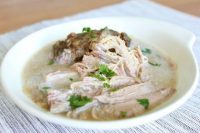 A great strategy for freezer-friendly meals is simply freezing portions of cooked meat. The meat can be defrosted and used to make a variety of different meals.
A great strategy for freezer-friendly meals is simply freezing portions of cooked meat. The meat can be defrosted and used to make a variety of different meals.
Shredded pork is a great example. Cook a whole pork shoulder, cool and shred it, then freeze in smaller portions. The defrosted pork can be used in salads, tacos, stir-fries, or as the main course with steamed veggies on the side. Korean short ribs also freeze well and can be turned into a quick meal.
Green Goddess Chicken Breasts
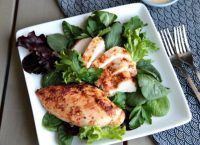 Cook a big sheet pan of Green Goddess chicken breasts, then shred the cooled meat and freeze.
Cook a big sheet pan of Green Goddess chicken breasts, then shred the cooled meat and freeze.
Like shredded pork, shredded chicken can be stored in smaller portions and defrosted for a wide variety of quick meals (stir-fries, tacos, salads, soups and stews). Add additional Green Goddess for flavor if desired.
Chili & “Cornbread“
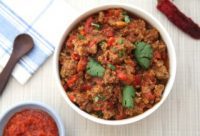 Any type of chili freezes well, but this lamb chili is especially delicious. For a complete meal (and delicious pairing), freeze a loaf of Primal cornbread, too.
Any type of chili freezes well, but this lamb chili is especially delicious. For a complete meal (and delicious pairing), freeze a loaf of Primal cornbread, too.
When freezing the cornbread, wrap tightly in plastic wrap or parchment paper, then put in a freezer bag.
Moroccan Meatball and Egg Tagine
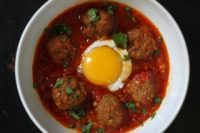 All types of meatballs freeze well. Defrost overnight in the refrigerator, then pop meatballs into lunchboxes, or reheat meatballs for dinner in a sauce like this one.
All types of meatballs freeze well. Defrost overnight in the refrigerator, then pop meatballs into lunchboxes, or reheat meatballs for dinner in a sauce like this one.
For Moroccan Meatball and Egg Tagine, freeze the meatballs and sauce together, then reheat slowly on the stove with ¼ cup water. Don’t freeze the eggs and fresh herbs—add them once the sauce and meatballs are reheated.
Lamb and Prune Tagine
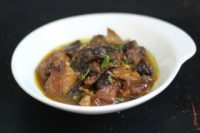 The complex flavors in this lamb and prune tagine are worth savoring over and over again, so make a double or triple batch to freeze.
The complex flavors in this lamb and prune tagine are worth savoring over and over again, so make a double or triple batch to freeze.
Defrost overnight in the refrigerator then gently reheat on the stove or in the oven (350 ºF) with a lid. Add ¼ to ½ cup liquid as the tagine reheats.
Picadillo
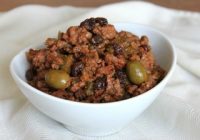
Picadillo is home cooked comfort food, the type of easy weeknight meal that both kids and adults love. Traditionally served over rice and beans (and sometimes, plantains) Primal Picadillo can be served over cauliflower rice or simply heaped in a bowl with nothing else. It’s also pretty great next to eggs for breakfast.
Picadillo is an easy recipe to double or triple. It reheats quickly on the stove or in the microwave.
Brisket
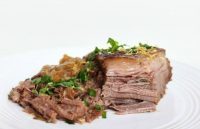 Brisket often tastes better when it’s been cooked and then reheated, so don’t worry about freezing this big piece of meat. Transfer a cooked and completely cooled brisket to a plastic freezer bag. Be extra diligent about squeezing out all the air out—getting out the air is really important to avoid freezer burn.
Brisket often tastes better when it’s been cooked and then reheated, so don’t worry about freezing this big piece of meat. Transfer a cooked and completely cooled brisket to a plastic freezer bag. Be extra diligent about squeezing out all the air out—getting out the air is really important to avoid freezer burn.
To defrost, put the cooked brisket in the fridge two days before you want to serve, then reheat, covered, in a 300 ºF degree oven. The meat will probably need additional salt before serving.
Beef Rendang
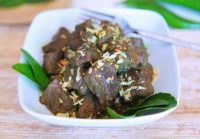 Fragrant and richly flavored beef Rendang requires two ingredients you might have to search for—galangal and kaffir lime leaves. This dish is well worth the effort, but you can make it doubly so by cooking a big batch so you can freeze an extra meal or two.
Fragrant and richly flavored beef Rendang requires two ingredients you might have to search for—galangal and kaffir lime leaves. This dish is well worth the effort, but you can make it doubly so by cooking a big batch so you can freeze an extra meal or two.
Reheat defrosted Rendang on the stove in a pot with an extra ½ cup coconut milk.
And Now for Today’s Giveaway…
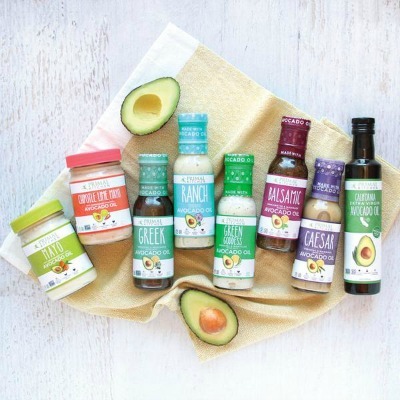 Today to spur your healthy eating goals (not to mention kitchen inspiration), I’m giving away two sets of our Advanced Keto Kit. These are some of our most popular Primal Kitchen® products, and for pursuing a keto lifestyle, they’ll offer flavorful options that don’t undermine your eating objectives.
Today to spur your healthy eating goals (not to mention kitchen inspiration), I’m giving away two sets of our Advanced Keto Kit. These are some of our most popular Primal Kitchen® products, and for pursuing a keto lifestyle, they’ll offer flavorful options that don’t undermine your eating objectives.
I’ll choose 2 random comments below as winners. Just tell me what recipes and cooking tips you’d like to see the Bees and I offer this year on Mark’s Daily Apple. Submit your comments by midnight tonight (1/4/18 PST).
Thanks for reading, everyone. Do you have further questions on freezing tips? Let us know!

The post 10 Freezer-Friendly Meals (and a Giveaway) appeared first on Mark's Daily Apple.



Primal Action Point: What Problem Will You Solve?
 I have a question for you today. Maybe it’s already part of your New Year vision. Or maybe it could help clarify a goal or add a new aim to your plan.
I have a question for you today. Maybe it’s already part of your New Year vision. Or maybe it could help clarify a goal or add a new aim to your plan.
What are you physically unable to do (comfortably) that you’d like to be able to do (comfortably)?
Just as the most effective type of exercise is the kind that you actually enjoy and are willing to do consistently, the most effective kind of fitness resolution aims to solve a problem that you actually have.
Think about the physical acts you’d like to be able to perform but currently cannot, like comfortably sit in a squat for ten minutes, play with your kids for a solid hour, hike a local mountain without feeling like you’re dying, participate in a charity 5K, do a pull-up, or deadlift twice your bodyweight. It could be anything really, as long as it’s something you actively want to do.
What deficit do you want to correct? What “problem” will you solve this year?
The post Primal Action Point: What Problem Will You Solve? appeared first on Mark's Daily Apple.



January 3, 2018
What Will 2018 Mean For Your Life? (And a Giveaway)
 Every New Year, the cynics are quick to tell you how arbitrary all the motivational messages, resolutions, and new beginnings are. It’s just another day, they grumble. And, sure, they have a point.
Every New Year, the cynics are quick to tell you how arbitrary all the motivational messages, resolutions, and new beginnings are. It’s just another day, they grumble. And, sure, they have a point.
You could start that new diet, join that new CrossFit box that just opened down the street, and finally pursue the dream job you’ve always wanted on March 7th, February 15th, or August 3rd. It doesn’t have to be January 1st. Any day will do. The New Year is somewhat arbitrary.
But we’re social animals who thrive in the presence of others. We feed off the energy around us to fuel our own initiative. On some level we’re always looking to what the group is doing for motivation, if not direction. The New Year presents a unique opportunity that way for all of us. Why would we not take advantage of the tailwind?
Taking that first step toward substantive change isn’t always easy. Taking the next steps each day can get lonely. The mood changes, however, when those around you are buzzing with the same intention. This time of year, whatever space you’re in, it’s often full of humans doing, planning, and discussing big changes. Some of it is false bravado of course. Many will fail. Many will never even begin. But the energy is there, it feels real, and it’s infectious. Wasting the global and local momentum would be a big mistake.
New Year’s cynic or no, there’s no better day than today. There isn’t even any other day than today. Yesterday is gone. Tomorrow hasn’t materialized. This moment is all that exists. It’s your only option. And—zip—there it went. Moments go fast. Better grab the next.
Yesterday’s post was a fantastic start. Erin’s WHY x5 is an essential tool for digging into your root desires and motivations for change. If you haven’t already, read it and go download the WHY x5 PDF. Fill it out and then come on back. I’ll wait.
Once you’ve figured out what you want to do, change, or become—and you have something (or somethings) very specific written down—it’s time to gather or shore up any knowledge and know-how you might be lacking. It’s important to know the nuts and bolts of Primal living, eating, and training, as you’ll presumably be utilizing them to enact the changes you desire.
Primal Resources Ready and Waiting
Many of you know these topics inside and out. Others do not. The former group can take the opportunity to discover what they’re missing, what they’ve forgotten, what they never knew. The latter group will be in uncharted territory. Here’s how to navigate:
1. Primal Blueprint Challenge page – On this page you’ll be introduced to the basics of the Primal Blueprint and can follow numerous links to learn more (including a link to join the 21-Day Challenge community on Vimify).
2. The Books – I’d especially recommend The New Primal Blueprint book if you haven’t picked it up already. With loads of updated information, graphics and details, it’s a comprehensive, go-to source for Primal living.
3. What to cook? – Check out the Primal Blueprint Recipes on MDA and our cookbooks as well as the suggestions in the 21-Day Total Body Transformation book.
4. The Newsletter – Sign up on this page to get several free ebooks, a 7-day course on the fundamentals of lifelong health, and more.
While we won’t be doing a formal 21-Day Challenge on MDA until late spring, we’ve got plenty of good in store.
As for the MDA blog, this month we’ll be focusing on practical, actionable information you can use to fuel your healthy 2018 intentions, and we’ll have giveaways throughout all of January to celebrate. Check back each day so you don’t miss your chance to take part!
Steep Yourself In Community
We’re social beings, remember? Books and blog posts and research can only get you so far. We also need the community, a living breathing thing that reacts and responds to you.
Sometimes you want to hear health and fitness experts have conversations about the types of topics that could change lives—like yours. Check out the Primal Blueprint Podcast hosted by Elle Russ (and sometimes Brad Kearns and myself), and the Primal Endurance Podcast hosted by Brad Kearns. Both are excellent.
There’s a great MDA Facebook group, extremely active and full of motivated posters, Primal Health coaches, and other enthusiasts. Go join so you can take part in the conversation (and have questions answered).
There’s also a Keto Reset Facebook group that you should join if you’re thinking about going keto. It gives you access to thousands of enthusiasts and experts who love talking about everything related to keto.
For either FB group, lurking is fine. You don’t have to participate, though you’ll probably derive more pleasure and success if you do.
The MDA forums are archived and read-only as of last month, but those archives contain valuable information and fascinating conversations between members on thousands of topics. It’s hard to summarize. Just go look.
You’ve got the tools, the knowledge, the goal in mind. Next comes the hard-easy part: action.
You stand at the base of a tall mountain, gazing up at your New Year’s goal glittering at the peak. There’s a path up, and it looks perilous but possible. Daunting but doable. You can do it. Will you? Take that first step and find out.
And Now A Giveaway For Your Thoughts…
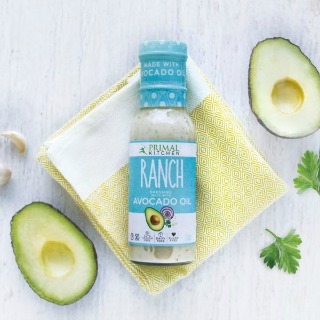 Now I’m going to ask you to fill in the next part. What do you need to make your intention happen—and what can we do on Mark’s Daily Apple to help you? What resources, topics, or ideas will give you a leg up? I’m looking for a whole swarm of possibilities, folks, so don’t be shy.
Now I’m going to ask you to fill in the next part. What do you need to make your intention happen—and what can we do on Mark’s Daily Apple to help you? What resources, topics, or ideas will give you a leg up? I’m looking for a whole swarm of possibilities, folks, so don’t be shy.
Let me know what your 2018 intentions are and how the bees and I can help you find success this year. No matter what your goal or your situation, the New Year can be the start of something big for your life.
I’ll choose 15 random commenters from the comment board below to receive a bottle of Primal Kitchen® Ranch Dressing—well, because the more, the merrier. Comment before midnight tonight (1/3/18 PST) to be eligible.
Thanks, everybody. Let’s make 2018 the best yet!
The post What Will 2018 Mean For Your Life? (And a Giveaway) appeared first on Mark's Daily Apple.



Mark Sisson's Blog
- Mark Sisson's profile
- 199 followers





